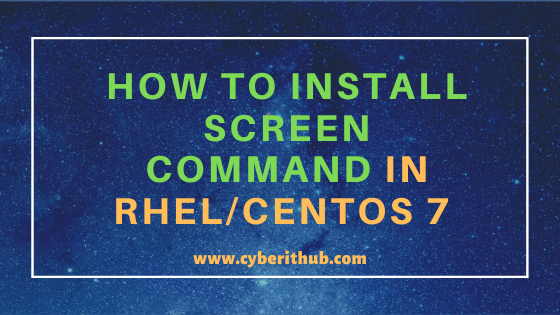Table of Contents
In this article, I will take you through the steps to Install Screen command in Linux (RHEL/CentOS 7/8) Using 4 Easy Steps. You might have faced a situation where you are running some important tasks in your Linux session but suddenly session got disconnected due to some issue and task got ended in between. This situation might be more disastrous when you are running important task like backup operations in Production Server and suddenly it got disconnected in between due to some reasons.
To handle these kind of situations, you can use screen command in Linux which can launch a separate session for any of the task you want to perform in your Server and then you can attach and detach the session as per your need. This utility is not available by default with Linux hence you need to install it separately using below steps.

Install Screen Command in Linux (RHEL / CentOS 7/8)
Also Read: How to Install VLC Media Player in RHEL / CentOS 8 Using 6 Easy Steps
Step 1: Prerequisites
a)You should have a running RHEL / CentOS 7/8 System.
b)You should have yum utility installed in your System. You can check Top 22 YUM Command Examples in RedHat / CentOS 7 to know more about yum utility.
c)You should have sudo access to run privileged commands in your System. You can check How to Add User to Sudoers to know more about providing sudo access to the User.
Step 2: Update Your System
First you need to update your System with latest release available using yum update -y command as shown below. This command will contact all configured yum repository to download and install the latest updates.
[root@localhost ~]# yum update -y Loaded plugins: fastestmirror Loading mirror speeds from cached hostfile * base: mirrors.praction.in * epel: mirror.telkomuniversity.ac.id * extras: mirrors.praction.in * updates: mirrors.praction.in Resolving Dependencies --> Running transaction check ---> Package ca-certificates.noarch 0:2019.2.32-76.el7_7 will be updated ---> Package ca-certificates.noarch 0:2020.2.41-70.0.el7_8 will be an update ---> Package dbus.x86_64 1:1.10.24-13.el7_6 will be updated ---> Package dbus.x86_64 1:1.10.24-14.el7_8 will be an update ---> Package dbus-libs.x86_64 1:1.10.24-13.el7_6 will be updated ---> Package dbus-libs.x86_64 1:1.10.24-14.el7_8 will be an update ---> Package kernel.x86_64 0:3.10.0-1127.13.1.el7 will be installed ---> Package kernel-headers.x86_64 0:3.10.0-1127.10.1.el7 will be updated ---> Package kernel-headers.x86_64 0:3.10.0-1127.13.1.el7 will be an update ---> Package kernel-tools.x86_64 0:3.10.0-1127.10.1.el7 will be updated ---> Package kernel-tools.x86_64 0:3.10.0-1127.13.1.el7 will be an update ---> Package kernel-tools-libs.x86_64 0:3.10.0-1127.10.1.el7 will be updated ---> Package kernel-tools-libs.x86_64 0:3.10.0-1127.13.1.el7 will be an update ---> Package libgudev1.x86_64 0:219-73.el7_8.6 install screen will be updated ---> Package libgudev1.x86_64 0:219-73.el7_8.8 install screen will be an update ---> Package microcode_ctl.x86_64 2:2.1-61.6.el7_8 install screen will be updated ---> Package microcode_ctl.x86_64 2:2.1-61.10.el7_8 will be an update ---> Package python-perf.x86_64 0:3.10.0-1127.10.1.el7 will be updated ---> Package python-perf.x86_64 0:3.10.0-1127.13.1.el7 will be an update
Step 3: Install Screen command in Linux
After successfully updating the System you now need to install screen utility in Linux using yum install screen -y command as shown below.
[root@localhost ~]# yum install screen -y Loaded plugins: fastestmirror Determining fastest mirrors epel/x86_64/metalink | 6.5 kB 00:00:00 * base: mirrors.praction.in * epel: mirror.telkomuniversity.ac.id * extras: mirrors.praction.in * updates: mirrors.praction.in base | 3.6 kB 00:00:00 epel | 4.7 kB 00:00:00 (1/3): updates/7/x86_64/primary_db | 3.0 MB 00:00:01 (2/3): epel/x86_64/primary_db | 6.9 MB 00:00:04 (3/3): epel/x86_64/updateinfo | 1.0 MB 00:00:49 Resolving Dependencies --> Running transaction check ---> Package screen.x86_64 0:4.1.0-0.25.20120314git3c2946.el7 will be installed --> Finished Dependency Resolution Dependencies Resolved ======================================================================================================================================================================== Package Arch Version Repository Size ======================================================================================================================================================================== Installing: screen x86_64 4.1.0-0.25.20120314git3c2946.el7 base 552 k Transaction Summary ======================================================================================================================================================================== Install 1 Package Total download size: 552 k Installed size: 914 k Downloading packages: screen-4.1.0-0.25.20120314git3c2946.el7.x86_64.rpm | 552 kB 00:00:00 Running transaction check Running transaction test Transaction test succeeded Running transaction Installing : screen-4.1.0-0.25.20120314git3c2946.el7.x86_64 1/1 Verifying : screen-4.1.0-0.25.20120314git3c2946.el7.x86_64 1/1 Installed: screen.x86_64 0:4.1.0-0.25.20120314git3c2946.el7 Complete!
Step 4: Check Screen command version
Now that screen utility is installed in the System, you can check the screen command version using screen -v command as shown below. As you can see from below output, current screen command version is 4.01.
[root@localhost ~]# screen -v Screen version 4.01.00devel (GNU) 2-May-06
Popular Recommendations:-
How to Disable IPV6 on Linux (CentOS / RHEL 7/8) Using 4 Best Steps
How to Set MariaDB root Password in RHEL/CentOS 7/8 Using Simple mysql_secure_installation
Introduction to SQL Injection Attacks in MySQL (v5.5)
How to Create Table in MySQL 5.5 with Easy Steps
How to Limit CPU Limit of a Process Using CPULimit in Linux (RHEL/CentOS 7/8)
How to Install Rust Programming Language in Linux Using 6 Best Steps
How to Install LEMP Stack on CentOS 8
Openssl Tutorial: Generate and Install Certificate on Apache Server in 8 Easy Steps
How to Enable or Disable SELinux Temporarily or Permanently on RedHat/CentOS 7/8
Top 12 Nmap Commands to Scan Remote Host with Best Practices
